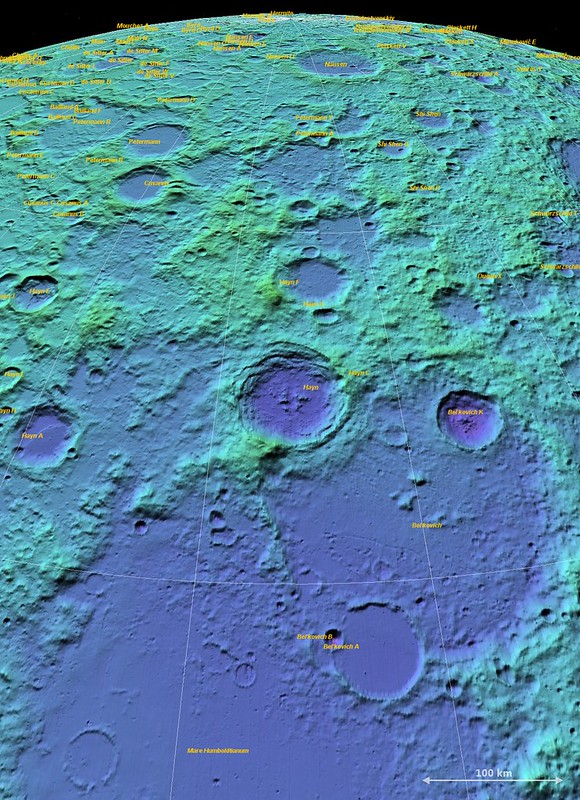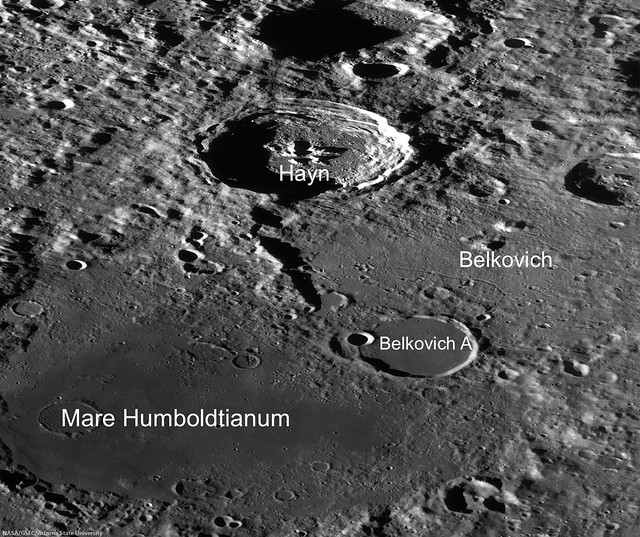 |
| Central peaks of Hayn crater, rising 1.5 km above the crater floor. Image is approximately 32 km across. LROC Narrow Angle Camera oblique mosaic M1105158497LR, orbit 15170, October 18, 2012; incidence angle 78.44° at a roughly estimated resolution of 4.7 meters per pixel. Spacecraft and camera slewed 57.46° east from nadir, 179.93 km over 68.01°N, 111.56°E [NASA/GSFC/Arizona State University]. |
H. Meyer
LROC News System
Hayn Crater (86.2 km, 64.55°N, 83.87°E) located just northeast of Mare Humboldtianum, is an exquisite example of a complex crater.
The central peak complex in the image above is dramatically illuminated by the low Sun casting long shadows across the crater floor.
The floor of Hayn crater contains spectacular remnants of the impact event: impact melt, slump blocks, and complex debris. In some areas, rocks on the floor have cracked and eroded into fields of boulders.
In the full oblique image above, the walls of Hayn display large terraces that formed in the final stage of crater formation, called the modification stage. They are the surface expression of concentric listric faults.
These faults develop as the transient cavity undergoes gravitational collapse. The formation of terraces widens the crater cavity and shallows out the floor. This downward movement of the walls and floor is followed by uplift in the center as the crust accommodates the stress of the impact.
Enjoy the exquisite full-resolution NAC oblique, HERE.
Related LROC Posts:
Craggy Peak, Impact Melts
Melt or Rubble?
View from the Other Side
LROC News System
Hayn Crater (86.2 km, 64.55°N, 83.87°E) located just northeast of Mare Humboldtianum, is an exquisite example of a complex crater.
The central peak complex in the image above is dramatically illuminated by the low Sun casting long shadows across the crater floor.
The floor of Hayn crater contains spectacular remnants of the impact event: impact melt, slump blocks, and complex debris. In some areas, rocks on the floor have cracked and eroded into fields of boulders.
 |
| A reduced resolution version of the full NAC oblique of Hayn crater (64.58°N, 83.89°E). Hayn is approximately 86 km in diameter. North at right; LROC Narrow Angle Camera oblique mosaic M1105158497LR, orbit 15170, October 18, 2012; incidence angle 78.44° at a roughly estimated resolution of 4.7 meters per pixel. Spacecraft and camera slewed 57.46° west of nadir, from 179.93 km over 68.01°N, 111.56°E [NASA/GSFC/Arizona State university]. |
 |
| Another, perhaps superfluous though certainly extraordinary, contexual view of Hayn with its emphasis on the crater's proximity with the Moon's north pole. LRO LOLA false color laser altimetry, at 128 points per pixel, through NASA's ILIADS application, a false perspective from 447 km over 55.3189°N, 78.7145°E, a point measured 4.127 km below mean global elevation (The image can be seen at its full size by clicking on it or HERE.) [NASA/GSFC/MSFC]. |
 |
| LRO WAC image for context. Orthographic projection, field of view is approximately 220 km across [NASA/GSFC/Arizona State University]. |
 |
| LROC Wide Angle Camera-derived digital terrain model showing Hayn is hemispheric context, orthographic projection centered on 60° East. Illustration to earlier LROC post "Craggy Peak, Impact Melts," January 12, 2012 [NASA/GSFC/Arizona State University]. |
Related LROC Posts:
Craggy Peak, Impact Melts
Melt or Rubble?
View from the Other Side


No comments:
Post a Comment